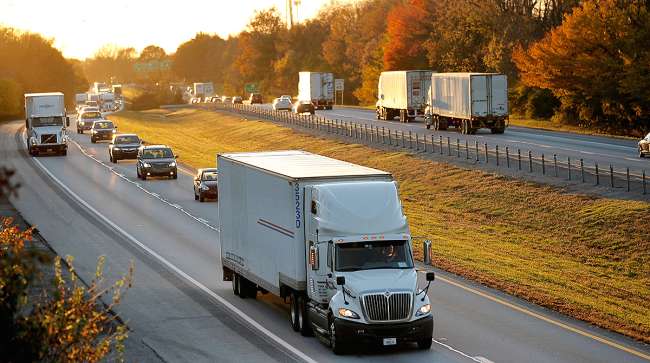Staff Reporter
Truck Tonnage Surges 7.3% in July

[Stay on top of transportation news: Get TTNews in your inbox.]
Truck tonnage surged 7.3% in July, the largest year-over-year gain since April, compared with July 2018, according to American Trucking Associations.
And tonnage increased 6.6% in July over June, according to ATA’s advanced seasonally adjusted For-Hire Truck Tonnage Index.
The not seasonally adjusted index, which represents the change in tonnage actually hauled by fleets before any seasonal adjustment, equaled 122.8 in July, 4.5% above the June level of 117.5. ATA’s research department said that in July, the index equaled 122.7 (in calculating the index, 100 represents 2015 levels), compared with 115.1 in June.
“Tonnage in 2019 has been on a roller coaster ride, plagued with large monthly swings, which continued in July as tonnage surged after falling significantly in May and June,” ATA Chief Economist Bob Costello said. “However, take out the month-to-month noise, and you see that truck tonnage is still on a nice upward path.
“It is important to note that ATA’s tonnage data is dominated by contract freight, which is performing significantly better than the plunge in spot market freight this year.”
“Tonnage in 2019 has been on a rollercoaster ride...however, take out the month-to-month noise, and you see that truck tonnage is still on a nice upward path." - @ATAEconBob — American Trucking (@TRUCKINGdotORG) August 20, 2019
June’s reading was revised downward compared with ATA’s July press release.
Trucking serves as a barometer of the U.S. economy, representing 70.2% of tonnage carried by all modes of domestic freight transportation, including manufactured and retail goods, according to ATA. A slowdown in trucking and freight likely would signal a recession, said economists and consultants who spoke to Transport Topics.
Noel Perry, an economist with Transport Futures, said while there are other signs of a slowdown in freight movement, the U.S retail sector remains strong.

Perry
Perry told TT that he forecasts a recession kicking off in the third quarter of 2020, conceding that even a slowdown can take months to mature.
“It takes a while for [a recession] to bake,” Perry said, adding sudden shocks such as oil prices or housing bubbles can accelerate downturns.
To another freight expert, ATA’s July tonnage number backs up his prediction the U.S. economy will escape a recession in 2019 and 2020, but there will be slower freight movement. In July, the freight sector clearly was moving inventories over highways, said Paul Bingham, director of IHS Markit.
Still, Bingham expects leaner times for trucking in the next 12 months.

Bingham
“There are signs of weakness seeping into freight demand,” he said. “The outlook is continued weakness.”
Perry and Bingham pointed to recent readings of the Purchasing Managers Index (PMI), a forecasting tool of the Institute for Supply Management.
The PMI is an “attitude survey,” said Bingham, an advance notice of future freight activity.
For July, the PMI registered 51.2%, a decrease of 0.5 percentage point from the June reading of 51.7 %, according to ISM. It was the lowest reading since August 2016, when the index registered 49.6%.
A reading above 50% indicates that the manufacturing economy generally is expanding; below 50% indicates that it is generally contracting, according to ISM.
“The PMI continued a period of expansion softening, with four straight months of expansion decline,” said Timothy Fiore, chairman of the ISM Manufacturing Business Survey Committee. “Softening this month was primarily due to slower growth in demand and consumption, indicated by the new orders, production and employment indexes. Four of the six big industries expanded, as was the case in June, but at lower levels.”
Yet in the long term, from 2019 to 2030, ATA expects tonnage to grow by more than 25%.
On Aug. 21, ATA released its Freight Transportation Forecast: 2019 to 2030, an annual projection of the state of the freight economy, showing continued growth in the industry.
“America’s trucking industry, and the overall freight transportation industry, are poised to experience strong growth over the next decade as the country’s economy and population grow,” Costello said.
Among the findings in this year’s forecast:
- Overall freight tonnage will grow to 20.6 billion tons in 2030, up 25.6% from 2019’s projection of 16.4 billion tons.
- Freight industry revenue will increase 53.8% to $1.601 trillion over the next decade.
- Trucking’s share of total freight tonnage will dip to 68.8% in 2030 from 71.1% this year, even as tonnage grows to 14.2 billion tons in 2030 from 11.7 billion tons.
- Trucking and total rail transportation will lose relative market share, even as revenue and tonnage grows, while intermodal rail, air and domestic waterborne transportation will show modest growth, and pipeline transportation will experience explosive growth — surging 17.1% in tonnage and 8.6% in revenue over the next decade.
“Freight Forecast clearly lays out why meeting challenges like infrastructure and workforce development are so critical to our industry’s success,” ATA President Chris Spear said. “It belongs on the desk of every decision maker in our industry and in the supply chain.”
Trucks hauled 10.77 billion tons of freight in 2017. Motor carriers collected $700.1 billion, or 79.3% of total revenue earned by all transport modes.
ATA calculates the tonnage index based on surveys from its membership and has been doing so since the 1970s. The tonnage number is a preliminary figure and subject to change in the final report issued around the fifth day of each month.




